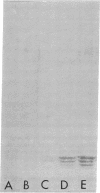Abstract
An IgG1 mouse monoclonal antibody produced in response to immunization with rat brain homogenate reacted with endothelial cells in the central and peripheral nervous system. Because antibody reactivity was associated with endothelia that have a selective permeability barrier, the antibody was called anti-endothelial-barrier antigen (anti-EBA). Paraffin sections of Bouins'-fixed rat tissue were used for initial screening and subsequent characterization of antibody reactivity. The antibody was generally unreactive with endothelial cells in other organs and with nonendothelial cells in or outside of the nervous system. Antibody binding was greatly reduced or absent in endothelia of the area postrema and choroid plexus, sites known to possess fenestrated blood vessels. In developing rat brain, anti-EBA binding to some microvessels was seen at 3 days postnatally. Anti-EBA reactivity outside the nervous system occurred in spleen and skin. Patchy reaction with portions of some spleen blood vessels and binding to some cells in the spleen were observed. In the skin, small cells, tentatively identified as Langerhans cells, which participate in Ia presentation, were stained. On immunoblots of rat brain microvessel preparations electrophoresed in Na-DodSO4/polyacrylamide gels, anti-EBA reacted with a protein triplet of Mr 30,000, 25,000, and 23,500 components.
Full text
PDF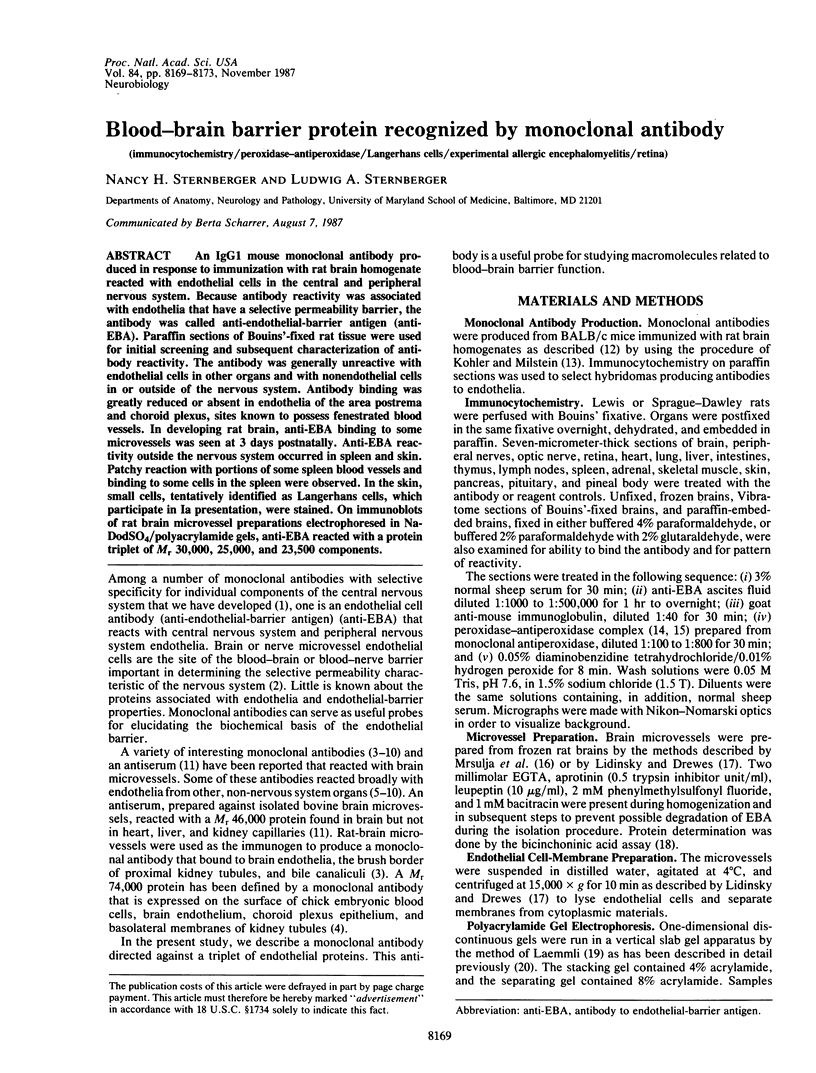
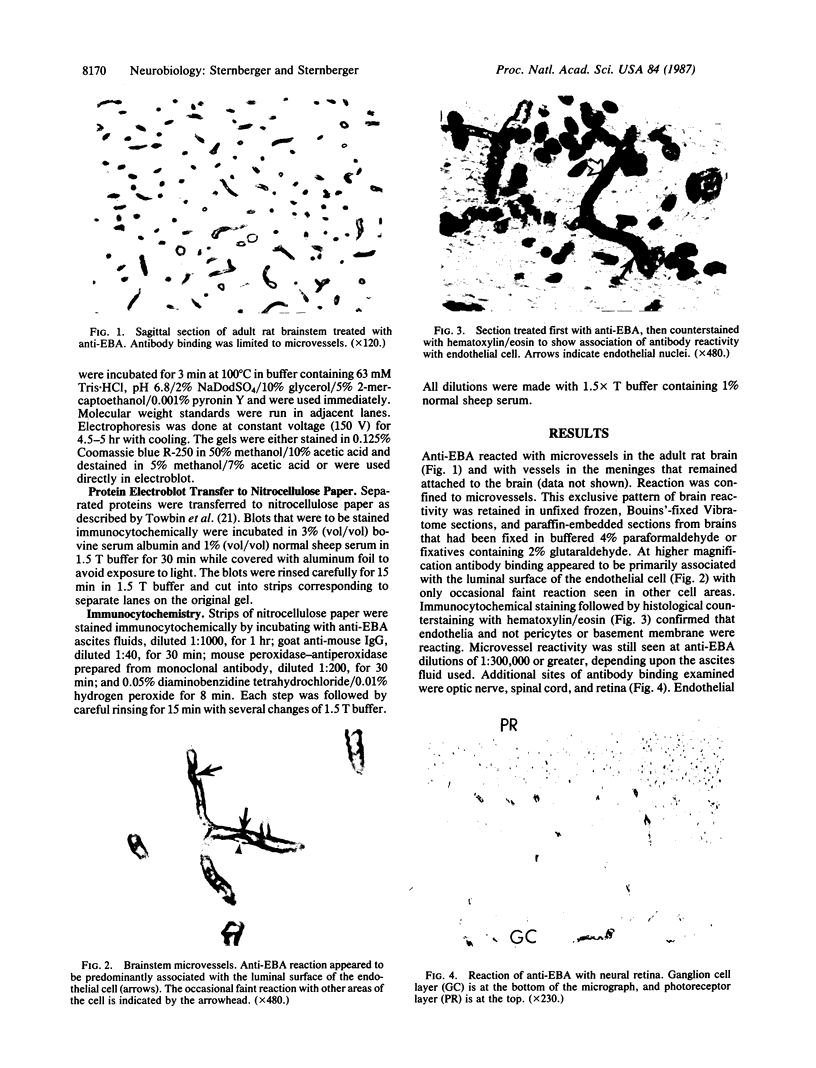
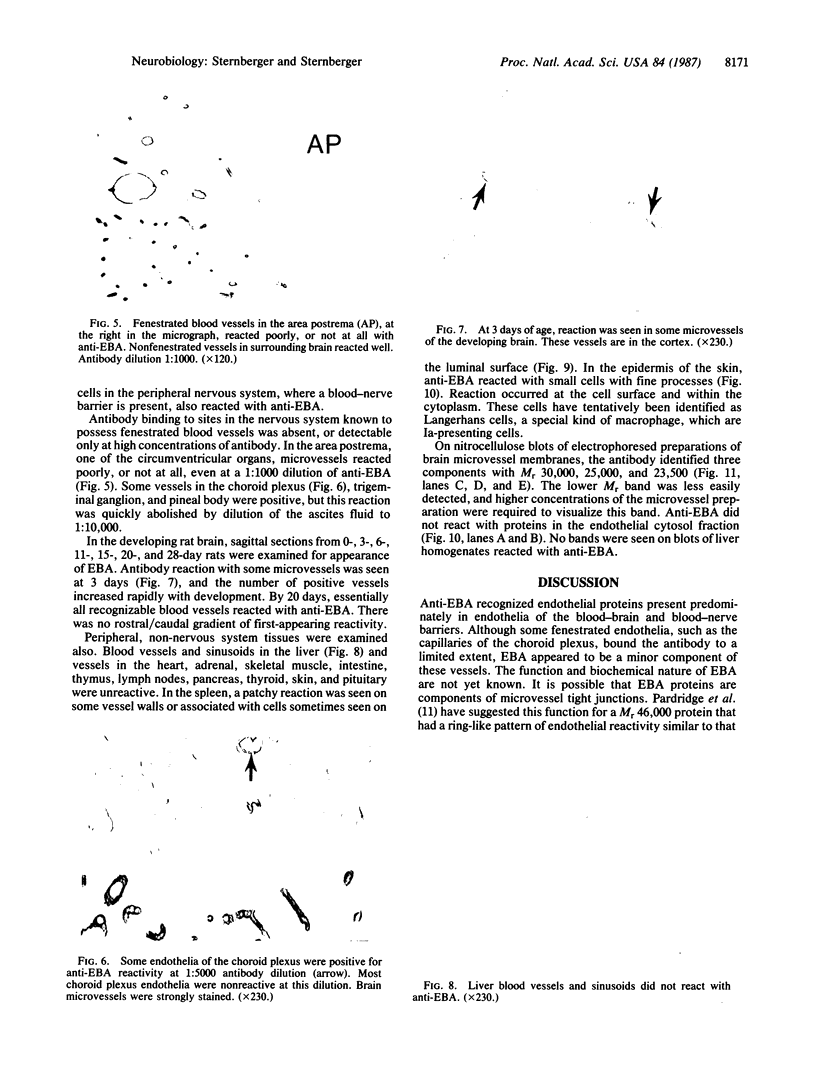
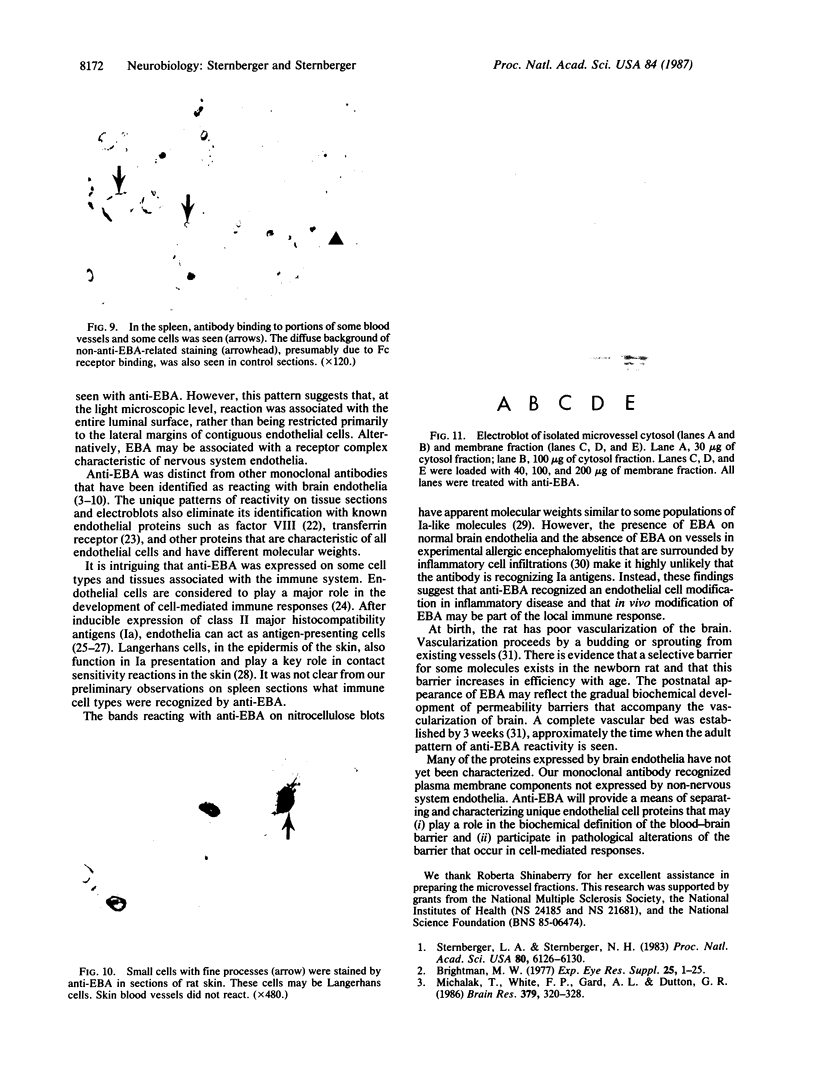

Images in this article
Selected References
These references are in PubMed. This may not be the complete list of references from this article.
- Alles J. U., Bosslet K. Immunohistochemical and immunochemical characterization of a new endothelial cell-specific antigen. J Histochem Cytochem. 1986 Feb;34(2):209–214. doi: 10.1177/34.2.2418100. [DOI] [PubMed] [Google Scholar]
- Arvieux J., Willis A. C., Williams A. F. MRC OX-45 antigen: a leucocyte/endothelium rat membrane glycoprotein of 45,000 molecular weight. Mol Immunol. 1986 Sep;23(9):983–990. doi: 10.1016/0161-5890(86)90129-x. [DOI] [PubMed] [Google Scholar]
- Brightman M. W. Morphology of blood-brain interfaces. Exp Eye Res. 1977;25 (Suppl):1–25. doi: 10.1016/s0014-4835(77)80008-0. [DOI] [PubMed] [Google Scholar]
- Burger D. R., Vetto R. M. Vascular endothelium as a major participant in T-lymphocyte immunity. Cell Immunol. 1982 Jul 1;70(2):357–361. doi: 10.1016/0008-8749(82)90336-7. [DOI] [PubMed] [Google Scholar]
- Ghandour S., Langley K., Gombos G., Hirn M., Hirsch M. R., Goridis C. A surface marker for murine vascular endothelial cells defined by monoclonal antibody. J Histochem Cytochem. 1982 Feb;30(2):165–170. doi: 10.1177/30.2.7061819. [DOI] [PubMed] [Google Scholar]
- Goldstein M. E., Sternberger L. A., Sternberger N. H. Microheterogeneity ("neurotypy") of neurofilament proteins. Proc Natl Acad Sci U S A. 1983 May;80(10):3101–3105. doi: 10.1073/pnas.80.10.3101. [DOI] [PMC free article] [PubMed] [Google Scholar]
- Hamburger A. W., Reid Y. A., Pelle B. A., Breth L. A., Beg N., Ryan U., Cines D. B. Isolation and characterization of monoclonal antibodies reactive with endothelial cells. Tissue Cell. 1985;17(4):451–459. doi: 10.1016/0040-8166(85)90024-2. [DOI] [PubMed] [Google Scholar]
- Jefferies W. A., Brandon M. R., Hunt S. V., Williams A. F., Gatter K. C., Mason D. Y. Transferrin receptor on endothelium of brain capillaries. Nature. 1984 Nov 8;312(5990):162–163. doi: 10.1038/312162a0. [DOI] [PubMed] [Google Scholar]
- Köhler G., Milstein C. Derivation of specific antibody-producing tissue culture and tumor lines by cell fusion. Eur J Immunol. 1976 Jul;6(7):511–519. doi: 10.1002/eji.1830060713. [DOI] [PubMed] [Google Scholar]
- Labastie M. C., Poole T. J., Péault B. M., Le Douarin N. M. MB1, a quail leukocyte-endothelium antigen: partial characterization of the cell surface and secreted forms in cultured endothelial cells. Proc Natl Acad Sci U S A. 1986 Dec;83(23):9016–9020. doi: 10.1073/pnas.83.23.9016. [DOI] [PMC free article] [PubMed] [Google Scholar]
- Laemmli U. K. Cleavage of structural proteins during the assembly of the head of bacteriophage T4. Nature. 1970 Aug 15;227(5259):680–685. doi: 10.1038/227680a0. [DOI] [PubMed] [Google Scholar]
- Lampson L. A., Levy R. Two populations of Ia-like molecules on a human B cell line. J Immunol. 1980 Jul;125(1):293–299. [PubMed] [Google Scholar]
- Lidinsky W. A., Drewes L. R. Characterization of the blood-brain barrier: protein composition of the capillary endothelial cell membrane. J Neurochem. 1983 Nov;41(5):1341–1348. doi: 10.1111/j.1471-4159.1983.tb00831.x. [DOI] [PubMed] [Google Scholar]
- Michalak T., White F. P., Gard A. L., Dutton G. R. A monoclonal antibody to the endothelium of rat brain microvessels. Brain Res. 1986 Aug 6;379(2):320–328. doi: 10.1016/0006-8993(86)90786-9. [DOI] [PubMed] [Google Scholar]
- Mrsulja B. B., Mrsulja B. J., Fujimoto T., Klatzo I., Spatz M. Isolation of brain capillaries: a simplified technique. Brain Res. 1976 Jul 9;110(2):361–365. doi: 10.1016/0006-8993(76)90408-x. [DOI] [PubMed] [Google Scholar]
- Mukai K., Rosai J., Burgdorf W. H. Localization of factor VIII-related antigen in vascular endothelial cells using an immunoperoxidase method. Am J Surg Pathol. 1980 Jun;4(3):273–276. doi: 10.1097/00000478-198006000-00008. [DOI] [PubMed] [Google Scholar]
- Pardridge W. M., Yang J., Eisenberg J., Mietus L. J. Antibodies to blood-brain barrier bind selectively to brain capillary endothelial lateral membranes and to a 46K protein. J Cereb Blood Flow Metab. 1986 Apr;6(2):203–211. doi: 10.1038/jcbfm.1986.33. [DOI] [PubMed] [Google Scholar]
- Pober J. S., Collins T., Gimbrone M. A., Jr, Libby P., Reiss C. S. Inducible expression of class II major histocompatibility complex antigens and the immunogenicity of vascular endothelium. Transplantation. 1986 Feb;41(2):141–146. doi: 10.1097/00007890-198602000-00001. [DOI] [PubMed] [Google Scholar]
- Risau W., Hallmann R., Albrecht U., Henke-Fahle S. Brain induces the expression of an early cell surface marker for blood-brain barrier-specific endothelium. EMBO J. 1986 Dec 1;5(12):3179–3183. doi: 10.1002/j.1460-2075.1986.tb04627.x. [DOI] [PMC free article] [PubMed] [Google Scholar]
- Schlingemann R. O., Dingjan G. M., Emeis J. J., Blok J., Warnaar S. O., Ruiter D. J. Monoclonal antibody PAL-E specific for endothelium. Lab Invest. 1985 Jan;52(1):71–76. [PubMed] [Google Scholar]
- Silberberg I., Baer R. L., Rosenthal S. A. The role of Langerhans cells in allergic contact hypersensitivity. A review of findings in man and guinea pigs. J Invest Dermatol. 1976 Apr;66(4):210–217. doi: 10.1111/1523-1747.ep12482139. [DOI] [PubMed] [Google Scholar]
- Smith P. K., Krohn R. I., Hermanson G. T., Mallia A. K., Gartner F. H., Provenzano M. D., Fujimoto E. K., Goeke N. M., Olson B. J., Klenk D. C. Measurement of protein using bicinchoninic acid. Anal Biochem. 1985 Oct;150(1):76–85. doi: 10.1016/0003-2697(85)90442-7. [DOI] [PubMed] [Google Scholar]
- Sobel R. A., Blanchette B. W., Bhan A. K., Colvin R. B. The immunopathology of experimental allergic encephalomyelitis. II. Endothelial cell Ia increases prior to inflammatory cell infiltration. J Immunol. 1984 May;132(5):2402–2407. [PubMed] [Google Scholar]
- Sternberger L. A., Hardy P. H., Jr, Cuculis J. J., Meyer H. G. The unlabeled antibody enzyme method of immunohistochemistry: preparation and properties of soluble antigen-antibody complex (horseradish peroxidase-antihorseradish peroxidase) and its use in identification of spirochetes. J Histochem Cytochem. 1970 May;18(5):315–333. doi: 10.1177/18.5.315. [DOI] [PubMed] [Google Scholar]
- Sternberger L. A., Harwell L. W., Sternberger N. H. Neurotypy: regional individuality in rat brain detected by immunocytochemistry with monoclonal antibodies. Proc Natl Acad Sci U S A. 1982 Feb;79(4):1326–1330. doi: 10.1073/pnas.79.4.1326. [DOI] [PMC free article] [PubMed] [Google Scholar]
- Sternberger L. A., Sternberger N. H. Monoclonal antibodies distinguish phosphorylated and nonphosphorylated forms of neurofilaments in situ. Proc Natl Acad Sci U S A. 1983 Oct;80(19):6126–6130. doi: 10.1073/pnas.80.19.6126. [DOI] [PMC free article] [PubMed] [Google Scholar]
- Towbin H., Staehelin T., Gordon J. Electrophoretic transfer of proteins from polyacrylamide gels to nitrocellulose sheets: procedure and some applications. Proc Natl Acad Sci U S A. 1979 Sep;76(9):4350–4354. doi: 10.1073/pnas.76.9.4350. [DOI] [PMC free article] [PubMed] [Google Scholar]
- Wagner C. R., Vetto R. M., Burger D. R. The mechanism of antigen presentation by endothelial cells. Immunobiology. 1984 Dec;168(3-5):453–469. doi: 10.1016/S0171-2985(84)80130-8. [DOI] [PubMed] [Google Scholar]











